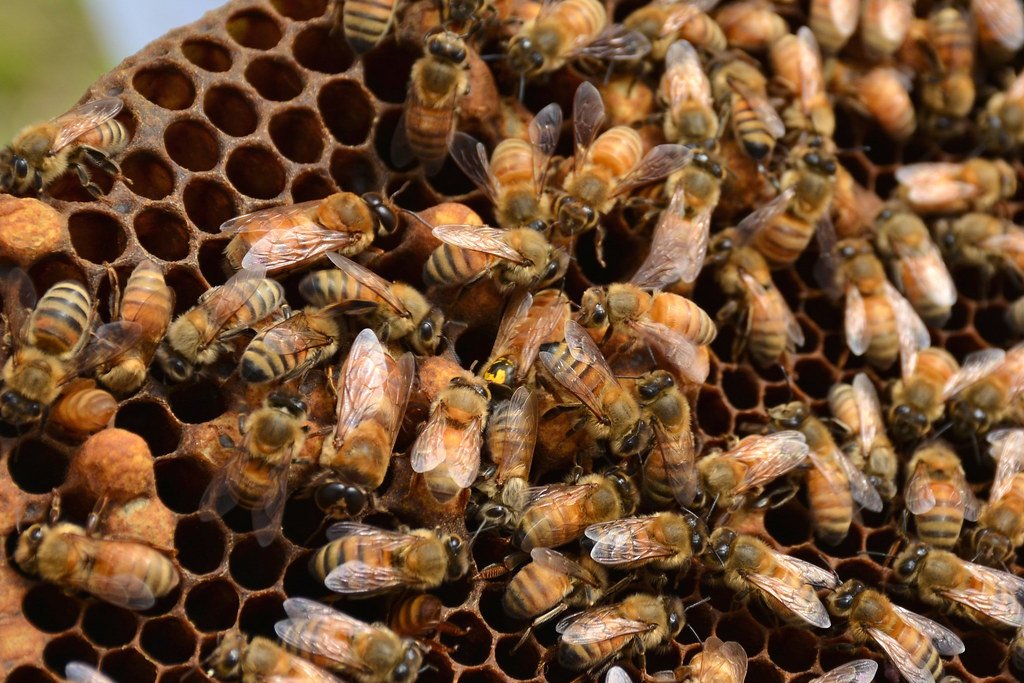Bees, those tiny busy creatures that grace us with the golden liquid of life, have been mesmerizing humans with their meticulous craftsmanship for centuries. Their hive, a masterpiece of architectural brilliance, is constructed using a variety of materials found in their environment. As apiarists and nature enthusiasts alike delve deeper into the world of beekeeping, there has been a growing inclination towards using natural hive materials. These materials, sourced straight from the Earth, offer a plethora of benefits that not only enhance the lives of the bees but also contribute to a more sustainable and environmentally friendly approach to beekeeping. In this article, we delve into the numerous advantages that come with embracing natural hive materials. So prepare to immerse yourself in the fascinating world of bees, where ancient wisdom meets modern eco-consciousness and discover the wonders that can unfold when we embrace nature’s own resources.
Table of Contents
- Introduction: The Advantages of Natural Hive Materials
- Enhancing Bee Health and Productivity with Natural Hive Materials
- Exploring Different Types of Natural Hive Materials
- The Environmental Impact of Natural Hive Materials
- Choosing the Right Natural Hive Material for Your Beekeeping Needs
- Q&A
- Future Outlook

Introduction: The Advantages of Natural Hive Materials
Discover the incredible benefits of using natural hive materials for beekeeping! By opting for organic and sustainable materials, you not only prioritize the well-being of your bees but also contribute to the conservation of the environment. Natural hive materials offer a plethora of advantages that can revolutionize your beekeeping experience.
First and foremost, natural hive materials are renowned for their exceptional durability. Crafted from sturdy substances like premium wood and eco-friendly wax, these materials ensure longevity and resilience in the face of changing weather conditions. This means that your hives will not only endure the elements but also provide substantial protection for your buzzing companions, allowing them to thrive and prosper.
- Better insulation: Natural hive materials, like insulating wood, help maintain optimal temperatures in the hive, protecting the bees from extreme heat or cold.
- Chemical-free environment: Choosing natural materials eliminates the risk of exposing your bees to harmful chemicals commonly found in certain synthetic hive components.
- Eco-conscious choice: By utilizing sustainable and renewable materials, you actively contribute to the preservation of our precious ecosystems.
- Aesthetic appeal: Natural hive materials lend an organic and rustic charm to your beekeeping setup, enhancing the visual appeal of your apiary.
Embrace the advantages brought forth by natural hive materials. Your bees will undoubtedly thank you for the nurturing and eco-friendly home you provide, while you revel in the joy of sustainable beekeeping!

Enhancing Bee Health and Productivity with Natural Hive Materials
In today’s era of sustainable and eco-friendly practices, beekeepers are increasingly turning to natural hive materials to enhance the health and productivity of their precious honeybee colonies. These alternative materials not only prioritize the well-being of our buzzing friends but also support a flourishing ecosystem.
When using natural hive materials, such as untreated wood, beeswax foundation, and straw skeps, several benefits emerge:
- Promoting Bee Health: Natural materials provide a more organic environment for bees, reducing the risk of chemical exposure that may harm their health. By avoiding the use of synthetic treatments or coatings, we allow bees to lead a healthier and more natural lifestyle.
- Encouraging Natural Behaviors: Honeybees have evolved in harmony with their surroundings, and providing them with natural hive materials encourages their natural instincts. The use of straw skeps, for instance, mimics the natural cavities that bees would typically inhabit in the wild.
- Optimizing Productivity: Natural hive materials often have insulating properties, allowing bees to regulate the temperature and humidity within their hives more efficiently. This optimization leads to a happier and more productive colony, resulting in increased honey yields and improved pollination.
By making a conscious shift towards natural hive materials, beekeepers can contribute to a sustainable future while ensuring the well-being and productivity of their awe-inspiring honeybee colonies.

Exploring Different Types of Natural Hive Materials
When it comes to beekeeping, one of the most important aspects is providing a safe and suitable home for our buzzing friends. In recent years, there has been a renewed interest in that are not only environmentally friendly but also provide a healthier living environment for the bees. Let’s dive into some of the fascinating options available:
1. Wooden Hives
Wooden hives have been a popular choice among beekeepers for centuries. They are not only aesthetically pleasing but also provide excellent insulation for the bees. The natural properties of wood help regulate temperature and humidity levels inside the hive, creating an ideal environment for the colony.
2. Straw Hives
Straw hives, also known as skeps, have a long history in traditional beekeeping. Made from tightly woven straw or reeds, these hives offer excellent ventilation and protection from the elements. Beekeepers who prefer a more rustic approach often find straw hives to be a charming addition to their apiary.
3. Clay Hives
For a touch of ancient tradition, clay hives provide a unique option. Crafted from clay and sometimes mixed with other natural materials, these hives offer good insulation and breathability for the bees. The porous nature of clay helps regulate moisture levels and offers a more natural habitat similar to that found in the wild, promoting the well-being of the colony.
As beekeepers, it’s crucial to consider the well-being of our beloved pollinators. By , we not only provide a healthy and sustainable living environment for bees but also contribute to their overall conservation.

The Environmental Impact of Natural Hive Materials
When it comes to beekeeping, it is vital to consider the environmental impact of the materials used in hives. Natural hive materials not only preserve the bees’ health and well-being but also minimize harm to the environment.
One of the most sustainable and eco-friendly hive materials is wood. Harvested from properly managed forests, wood provides a renewable and biodegradable option for constructing beehives. The use of wood helps to reduce our carbon footprint and contributes to the preservation of forest ecosystems.
In addition to wood, another natural material gaining popularity among beekeepers is straw. Straw hives offer a traditional and environmentally friendly alternative to conventional hives. These hives are often made from readily available agricultural byproducts, reducing waste and promoting a circular economy.
- Benefits of Natural Hive Materials:
- Minimize the use of non-renewable resources
- Reduce pollution and waste
- Support sustainable practices and biodiversity
- Promote a healthier beekeeping ecosystem
By choosing natural hive materials, beekeepers contribute to the conservation of natural resources, protect the environment, and support the overall wellbeing of honeybee colonies. It is important to prioritize the long-term sustainability of beekeeping practices for the sake of both bees and our planet.
Choosing the Right Natural Hive Material for Your Beekeeping Needs
Embarking on a beekeeping journey means taking careful consideration of the hive material that will not only ensure the well-being of your buzzing friends but also enhance the success of your honey production. With a variety of natural hive materials available, it’s important to select the one that best aligns with your specific beekeeping needs.
One option worth considering is cedar wood. Known for its durability and resistance to rot, cedar wood provides an excellent choice for longevity and weather resistance. Additionally, its natural oils act as a deterrent to pests such as moths and termites, keeping your hive safe from potential invaders. Another advantage of cedar wood is its insulating properties, helping to regulate temperature and moisture levels, which could be beneficial in extreme climates.
Another popular choice is straw skep hives. These traditional and visually appealing hives made from woven straw possess excellent ventilation properties, keeping the hive cool in hot weather. Straw skeps also provide a cozy and natural environment for the bees, mimicking the conditions of a wild hive. However, it’s worth noting that these hives have their limitations when it comes to hive inspections, as dismantling them can be more challenging than other types of hives.
Q&A
What are natural hive materials?
Natural hive materials refer to the use of materials found in nature to construct beehives, such as wood, straw, and clay, rather than synthetic or manufactured alternatives.
What are the benefits of using natural hive materials?
Using natural hive materials offers several advantages. They are more eco-friendly, as they don’t require the energy-intensive manufacturing processes needed for synthetic materials. They also provide a healthier habitat for bees, as natural materials regulate temperature and humidity better.
Do natural hive materials affect bee health?
In fact, natural hive materials can significantly improve bee health. Materials like wood and straw provide better insulation and ventilation, reducing the risk of mold and fungi growth. This promotes a cleaner environment that is less prone to disease, ultimately supporting stronger and more resilient bee colonies.
Are natural hive materials more expensive?
While natural hive materials may have a slightly higher upfront cost, they can be more cost-effective in the long run. Natural materials are known for their durability, with wooden hives lasting for several years without the need for frequent replacements. This reduces the overall expenses of maintaining and replacing synthetic hive materials.
What impact does the use of natural hive materials have on honey production?
Using natural hive materials can positively impact honey production. These materials mimic the natural environment of bees, allowing them to build their combs without interference. The absence of synthetic chemicals and odors in natural hive materials also preserves the taste and quality of the honey they produce.
Can natural hive materials benefit the environment?
Yes, natural hive materials contribute to environmental conservation. Their use promotes the reduction of waste and pollution associated with synthetic alternatives. Furthermore, natural materials are often biodegradable, ensuring minimal impact on the environment when they reach the end of their lifecycle.
Are there any challenges to using natural hive materials?
One challenge of using natural hive materials is their susceptibility to damage caused by weather conditions, pests, and regular wear and tear. However, proper treatment and maintenance can minimize these risks, ensuring the durability and longevity of the hive.
Are there any regulations surrounding the use of natural hive materials?
Regulations regarding hive materials may vary depending on the region. It is essential to consult local beekeeping associations or regulatory bodies for guidelines on the appropriate use of natural hive materials and ensure compliance with any legal requirements.
Future Outlook
In a world where synthetic materials often dominate, it’s refreshing to explore the wonders of nature’s own craftsmen: bees. The benefits of natural hive materials are truly something to be marvelled at, offering both our buzzing friends and us a myriad of advantages. From the warmth and resilience of beeswax to the breathability and antibacterial properties of honeycomb, these hive materials provide us with a glimpse into the artistry and wisdom of the insect realm.
As we delve deeper into the world of honeybees and their natural hive materials, it becomes evident that nature has bestowed upon these tiny creatures an unparalleled ability to create sustainable and effective habitats. With beeswax acting as the bees’ architectural masterpiece, it provides them with a warm and structured home, while simultaneously allowing for optimal airflow, preventing the accumulation of harmful moisture or condensation. This natural insulation is a testament to the bees’ ingenuity and is now being acknowledged by humans for its potential benefits in our own constructions.
Moreover, the intrinsic antibacterial properties found in honeycomb make it a remarkable substance within the hive. As the bees cultivate and nourish their young ones, these hexagonal wonders safeguard the colony from harmful bacteria and microbes. Additionally, they help in preserving the purity and flavor of the golden nectar we know as honey. It is truly awe-inspiring how bees have instinctually crafted such intricate and practical materials that stand the test of time.
The benefits of natural hive materials extend beyond the confines of our backyard apiaries. Nowadays, we find ourselves increasingly drawn to sustainable and eco-friendly alternatives across various industries. Harnessing the beauty of these natural materials offers us a more sustainable way of constructing, creating products, and even nourishing our bodies. With the advent of innovative research and experimentation, we are rediscovering the potential of beeswax and honeycomb as versatile and reliable materials. From cosmetics to medicine, and from architecture to food, the possibilities seem to be endless.
In a world where nature’s brilliance is often overlooked, the benefits of natural hive materials serve as a gentle reminder to embrace and protect the wonders that surround us. The intricate craftsmanship of bees and their hive materials offers not only an opportunity to connect with the natural world but also a chance for us to learn from their sustainable practices. With each hive being a testament to their triumphs, let us appreciate and incorporate the marvels of beeswax and honeycomb into our lives, and in doing so, create a harmonious coexistence with our buzzing allies.
As an affiliate, my content may feature links to products I personally use and recommend. By taking action, like subscribing or making a purchase, you’ll be supporting my work and fueling my taco cravings at the same time. Win-win, right?
Want to read more? Check out our Affiliate Disclosure page.